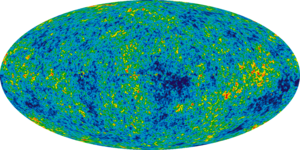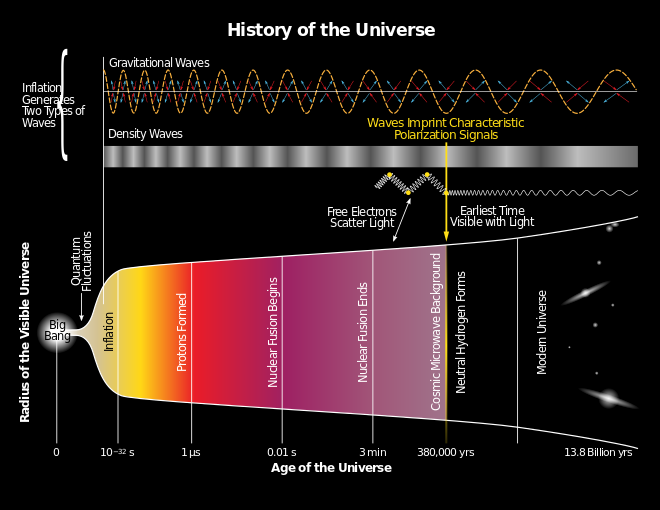تضخم كوني
| جزء من سلسلة عن |
| علم الكون الطبيعي |
|---|
 |
تضخم كوني قد تكون بداية التأكيد العملي لنظرية الانفجار العظيم قد بدأت مع رصد الفلكي الامريكي هابل للمجرات و محاولة تعيين بعد هذه المجرات عن الأرض مستخدما مفهوم لمعان النجوم الذي يتعلق بسطوع النجوم وبعدها عنا. وبتمدد الكون أصبح بارداً. وقد كشف عن وجود هذا الإشعاع عالما الفيزياء الأمريكيان آرنو بنزياس وروبرت ولسون عام 1965م. فقد وجدا أن درجة حرارة هذا الإشعاع تزيد على الصفر المطلق ( -273,15 ° م ) بنحو 2,7 ° م وهو رقم قريب لما جدده جامو وزميلاه. وحري أن نذكر أن الإشعاع الحراري يصدر من الاتجاهات كافة، ويُبقي درجة حرارته ثابتة في جميع الاتجاهات.
لم تشرح نظرية الانفجار العظيم الأصلية كيفية تماثل واتساق درجة حرارة الإشعاع الحراري في الاتجاهات كافة، ولكن قدمت نظرية إضافية تعرف باسم تضخم الكون شرحاً وافياً لهذه الظاهرة. وطبقاً لهذه النظرية فإن الكون قد تمدد بدرجة كبيرة بعد الانفجار مباشرة. وقد أدى هذا التمدد الكبير، بنص النظرية، إلى تقليل التفاوت بين درجات الحرارة في مناطق شاسعة من الكون. كما أدى التفاوت الطفيف في الكثافة إلى تكون المجرات.
يبدو أن الكون يتمدد بمعدل متزايد. ويرجح أن القوة الطاردة التي تنظم الكون باتساق محكم وتعرف باسم الثابت الكوني هي المسؤولة عن سرعة هذا التمدد. وكان العالم ألبرت أينشتاين، الألماني المولد، أول من أشار إلى هذه القوة. والثابت الكوني هو الثابت الضربي لحد يتناسب مع الجزء المتري في معادلة أينشتاين الذي يربط أنحاء الفضاء بموتر الطاقة. وقد أفصح أنيشتاين عن هذه الفكرة خلال بحث قدمه عام 1917م يتضمن تطبيقاً لنظريته النسبية العامة في الكون.
استعراض
النظرية
An expanding universe generally has a cosmological horizon, which, by analogy with the more familiar horizon caused by the curvature of Earth's surface, marks the boundary of the part of the Universe that an observer can see. Light (or other radiation) emitted by objects beyond the cosmological horizon in an accelerating universe never reaches the observer, because the space in between the observer and the object is expanding too rapidly.

Space expands
In a space that expands exponentially (or nearly exponentially) with time, any pair of free-floating objects that are initially at rest will move apart from each other at an accelerating rate, at least as long as they are not bound together by any force. From the point of view of one such object, the spacetime is something like an inside-out Schwarzschild black hole—each object is surrounded by a spherical event horizon. Once the other object has fallen through this horizon it can never return, and even light signals it sends will never reach the first object (at least so long as the space continues to expand exponentially).
In the approximation that the expansion is exactly exponential, the horizon is static and remains a fixed physical distance away. This patch of an inflating universe can be described by the following metric:[4][5]
This exponentially expanding spacetime is called a de Sitter space, and to sustain it there must be a cosmological constant, a vacuum energy density that is constant in space and time and proportional to Λ in the above metric. For the case of exactly exponential expansion, the vacuum energy has a negative pressure p equal in magnitude to its energy density ρ; the equation of state is p=−ρ.
Inflation is typically not an exactly exponential expansion, but rather quasi- or near-exponential. In such a universe the horizon will slowly grow with time as the vacuum energy density gradually decreases.
Few inhomogeneities remain
انظر أيضاً
ملاحظات
المراجع
- ^ Staff (17 March 2014). "BICEP2 2014 Results Release". National Science Foundation. Retrieved 18 March 2014.
- ^ Clavin, Whitney (17 March 2014). "NASA Technology Views Birth of the Universe". NASA. Retrieved 17 March 2014.
- ^ Overbye, Dennis (17 March 2014). "Space Ripples Reveal Big Bang's Smoking Gun". The New York Times. Archived from the original on 2022-01-01. Retrieved 17 March 2014.
- ^ Melia, Fulvio (2008). "The Cosmic Horizon". Monthly Notices of the Royal Astronomical Society. 382 (4): 1917–1921. arXiv:0711.4181. Bibcode:2007MNRAS.382.1917M. doi:10.1111/j.1365-2966.2007.12499.x. S2CID 17372406.
- ^ Melia, Fulvio; et al. (2009). "The Cosmological Spacetime". International Journal of Modern Physics D. 18 (12): 1889–1901. arXiv:0907.5394. Bibcode:2009IJMPD..18.1889M. doi:10.1142/s0218271809015746. S2CID 6565101.
المصادر
- Guth, Alan (1997). The Inflationary Universe: The Quest for a New Theory of Cosmic Origins. Perseus. ISBN 978-0-201-32840-0.
- Hawking, Stephen (1998). A Brief History of Time. Bantam. ISBN 978-0-553-38016-3.
- Hawking, Stephen; Gary Gibbons (1983). The Very Early Universe. Cambridge University Press. ISBN 978-0-521-31677-4.
- Kolb, Edward; Michael Turner (1988). The Early Universe. Addison-Wesley. ISBN 978-0-201-11604-5.
- Linde, Andrei (2005). Particle Physics and Inflationary Cosmology. Contemporary Concepts in Physics. Vol. 5. pp. 1–362. arXiv:hep-th/0503203. Bibcode:2005hep.th....3203L. ISBN 978-3-7186-0490-6.
{{cite book}}:|journal=ignored (help) - Linde, Andrei (2006). "Inflation and String Cosmology". Progress of Theoretical Physics Supplement. 163: 295–322. arXiv:hep-th/0503195. Bibcode:2006PThPS.163..295L. doi:10.1143/PTPS.163.295. S2CID 119410403.
- Liddle, Andrew; David Lyth (2000). Cosmological Inflation and Large-Scale Structure. Cambridge. ISBN 978-0-521-57598-0.
- Lyth, David H.; Riotto, Antonio (1999). "Particle physics models of inflation and the cosmological density perturbation". Physics Reports. 314 (1–2): 1–146. arXiv:hep-ph/9807278. Bibcode:1999PhR...314....1L. doi:10.1016/S0370-1573(98)00128-8. S2CID 119517140.
- Mukhanov, Viatcheslav (2005). Physical Foundations of Cosmology. Cambridge University Press. ISBN 978-0-521-56398-7.
- Vilenkin, Alex (2006). Many Worlds in One: The Search for Other Universes. Hill and Wang. ISBN 978-0-8090-9523-0.
- Peebles, P. J. E. (1993). Principles of Physical Cosmology. Princeton University Press. ISBN 978-0-691-01933-8.
وصلات خارجية
- Was Cosmic Inflation The 'Bang' Of The Big Bang?, by Alan Guth, 1997
- قالب:Cite arxiv
- update 2004 by Andrew Liddle
- قالب:Cite arxiv
- قالب:Cite arxiv
- The Growth of Inflation Symmetry, December 2004
- Guth's logbook showing the original idea
- WMAP Bolsters Case for Cosmic Inflation, March 2006
- NASA March 2006 WMAP press release
- Max Tegmark's Our Mathematical Universe (2014), "Chapter 5: Inflation"

